6 – Brunnstrom – Movement Therapy – Flashcards
Unlock all answers in this set
Unlock answersquestion
1. Trail and error 2. Hierrachical control 3. Reflex model
answer
Neurophysiological Approach based on clinical observation of hemiplegia (3)
question
Attemps to affect the nervous system intself
answer
Movement Therapy
question
1. Coupling of muscles in orderly way for purposeful movement 2. Can be recombined
answer
Normal synergy (2)
question
Condition of motor/sensory defecit on one half of the body that is OPPOSITE the side of brain lesion

answer
Hemiplegia
question
1 - stereotypes 2 - can not be recombined 3 - primitive 4 - automatic 5 - reflexsive 6 - obligatory
answer
Post Stroke Synergies (6)
question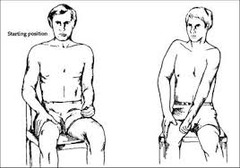
Flexor and Extensor synergies of the UE and LE

answer
Pathologic Synergy
question
When we start to see activity come in first it comes via dominant components *As flaccidity resolves the dominant component of synergy are the first to show increased tone*
answer
Dominant Components
question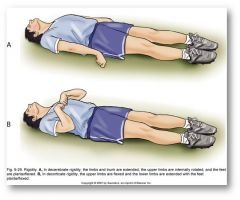
Elbow flexion! -retraction/elevation of shoulder girdle -shoulder ER -shoulder ABD -elbow FLX -Forearm supination

answer
Dominant Components: (UE flexor synergy)
question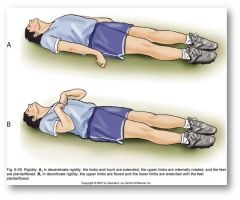
-retraction/elevation of shoulder girdle -shoulder ER -shoulder ABD -elbow FLX -Forearm supination

answer
-UE flexor synergy
question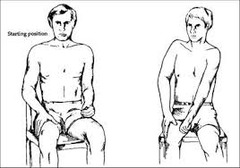
Pec Major ^shoulder ADD (IR) ^Pronation

answer
Dominant Components: (UE Extensor synergy)
question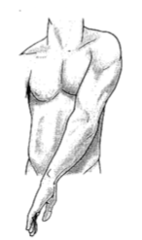
-fixation of shoulder in protracted pattern -shoulder IR -Add of arm across body -Elbow EXT -Forarm pronation

answer
-UE Extensor synergy
question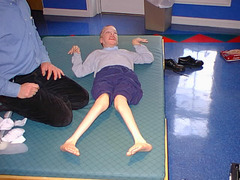
Hip Flexion

answer
Dominant components: (Flexor Synergy LE)
question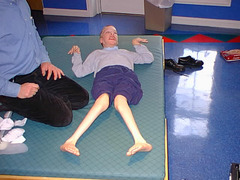
-Hip Flexion -Hip ABD. ER -Knee flexion -Foot DF, Inversion

answer
-Flexor Synergy LE
question
Knee extension
answer
Dominant components: (Extensor synergy of LE)
question
-Hip extension -Hip ADD, IR -Knee EXT -Ankle PF and Inversion
answer
-Extensor synergy of LE
question
Perpetuates synergy imbalance
answer
Reciprocal Inhibition
question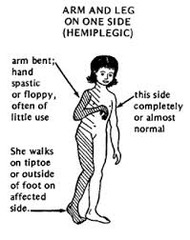
-Shoulder ADD (IR) -Elbow FLX -Pronation

answer
Typical posture of UE (3)
question
EFFORT
answer
What increases tone
question
Elicit normal motor activity by reflexes ***You want any movement because reflexes are needed before normal movement can occur
answer
How can you elicit synergies? Why would you want to do this...?
question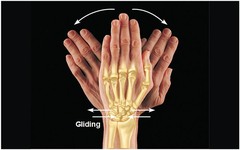
Encourage movement by any means!!

answer
Brunnstrom Technique
question
Synergy (with use of reflexes)
answer
Facilitate movement via.....
question
1. Symmetric Tonic Neck = FLX facilitates flexion of UE and extension of LE -Extension facilitates extension of the UE and flexion of the LE 2. Assymmetric Tonic Neck = Extension of the jaw side and flexion of the skull side
answer
Reflex Facilitation (2)
question
EFFORT! (BOS, COG, distractions, difficulty of task)
answer
How to recruit activity without all-or-none
question
Can recruit without all-or-none synergy patterns
answer
Pull down effort
question
Supine facilitates extension Prone facilitates flexion
answer
Reflex Facilitation -Tonic Labyrinthe
question
UE flexion --> Flexion and extension --> Extension LE opposite in sagittal plane LE symmetric in frontal plane
answer
Reflex Facilitation -Associated Reactions
question
***Pathological but GOOD for Brunnstrom Forced involuntary efforts will elicit associated reactions (ex: cough forcefully and arm moves)
answer
Associated Reactions
question
1. Souque's Finger Phenomenon = raise shoulder and palm of hand to 90 degrees, get finger extension 2. Tonic Thumb Reflex = hand gripped, ABD metacarpal from hand (relax flexors) 2. Homolateral limb synkinesis = same side arm and leg. Same movement --> to get UE ADD do LE ADD
answer
*Useful associated reactions (3)*
question
WB to promote co-contraction and facilitate extension Proximal traction or quick stretch to facilitate flexors
answer
Facilitation -how to promote extensors -how to promote flexors
question
1. Flaccidity 2. Synergy present and some spasticity 3. Voluntary control over some components of synergy and spasticity peaks (not always all-or-none) 4. Out of synergy movement and spasticity declines 5. Synergy losing dominance 6, Individual joint movement and spasticity essentially gone 7. Recovery
answer
Stages of Recovery (7)
question
Critical Sensory impairment is critical to the prognosis for functional recovery
answer
Sensory Involvement is _______ -why?
question
Synergies (reflexes) --> Gross mvt --> Proximal mvt --> Distal movement
answer
Recovery from Stroke --> --->
question
SUCCESS

answer
Movement Therapy needs _____
question
Small fairlure is monumental, looks for alternatives
answer
Failure is detrimental, why?
question
Understand how hard the task is and is it in their capacity?
answer
How to build success?
question
1. Avoid posturing 2. Position out of dominant component of synergies 3. Early mobility a. bed mobility --> roll toward affected side b. balance training --> evoke reflexsive response
answer
Treatment Approach (2)
question
A normal sequence and the voluntary control over the basic synergies is required for prerequistie to control over more advanced movement patterns
answer
Stages of Recovery are
question
Synergies
answer
Use reflexes (elciting a flexor withdrawl stimulus) to get
question
Encouring voluntary initiation
answer
Foundation of treatment
question
NO
answer
Do you have to perfect the skill before moving on to the next?
question
1. uses reflexes and associated reactions to stimulate motor activity 2. superimposes volitional activity 3. when pt can iniate on own withdrawl reflex support 4. move to out of synergy patterns
answer
4 notes on movement system
question
1. Isoltate knee flexion 2. Combine knee flexion with hip extension
answer
2 ways to move out of synergy
question
Normally gait is automatic -don't walk in paralel bars, walk when you are ready! ***Automating Patterns
answer
Brunnstrom approach to gait (basic idea)
question
Don't walk in the early stages post stroke, do not want to allow pt to develope bad patterns *instead, do pre-gait activities*
answer
Explain automating patterns
question
1. Hip flexion and facilitate voluntary control of hip 2. Work on DF activation and then control of DF out of synergy and in particular with knee extension as you need it in gait 3. Varied heights of seated surface to change amt of hip extension while working on distal component control 4. Sit to stand activiteis and WB 5. Standing in dynamic exercises - to promote bilateral ABD 6. Plantigrade 7. Mini squats 8. Weight shifts and trunk rotation
answer
Pre-gait Activities (8)
question
1. Don't walk early (stage 1-3) post-stroke 2. Gait preparation early] 3. Gait w/out Assistive device 4. No verbal cues --> gait is automatic
answer
Brunnstrom Approach to Gait (4)



